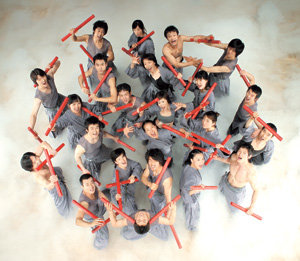Taekwondo: Poetry of the Body

The Moon: Knights of the Silver Moon, a nonverbal performance on the theme of Taekwondo which garnered much attention from its initial production announcement, is finally revealing its shape.
The Gyeonggi Arts Center commissioned Russian director Victor Kramer, famed worldwide for Slavas Snow Show, with the creation of The Moon. The production cost a total of one billion won. With the curtain set to rise for the first time on May 20 at the National Theater of Korea in Seoul, the troupe is hard at work perfecting their performance. Dong-A Ilbo visited the busy scene of the rehearsal for The Moon.
Seven Taekwondo Masters, a Combined Martial Arts Grade of 47-
4:00 p.m. on May 7, at the Gyeonggi Arts Center rehearsal hall, the stinging odor of poultices assailed my nostrils the moment I opened the door. There was no need to hear the explanation that the company members were jumping and rolling for over 10 hours a day to know the kind of grueling work that went on.
Okay, forms! One, two, three, four, five, six, seven, eight. And again!
A blue-eyed choreographer, who is accompanying Kramer during his time in Korea, was keeping time for the troupe. He couldnt speak a word of Korean at first, but now he commands a few choice words like again (dasi), slowly (cheoncheonhi), quickly (bballi), and all together (da hamgge).
The scene in rehearsal was the mirror episode, in which seven Taekwondo warriors face off against seven giants. When a black-clad giant unfurls his cape, a large mirror makes its appearance, and the warriors compete with their own reflections in a battle of creative forms. The scene reflects the philosophy that all battles are ultimately struggles against the self. Such basic Taekwondo moves as the diamond block and the knife hand block are blended with dance, in alternately graceful and fierce movements.
Because the warriors are dressed in light-absorbing black with white bandages wrapped around their hands and feet, from the audiences vantage point it looks as if the hands and feet are the only things moving on the stage. Their trajectories as they whirled dynamically to the strong beats of a percussion accompaniment drew white circles in the air and created a powerful visual effect.
Next followed a rehearsal of the festival episode, reputed to be the most spectacular scene in The Moon. Twenty performers with red bamboo staves gripped in either hand crisscrossed one another with pinpoint accuracy, in an elaborate group number that combines Taekwondo with modern dance.
The Moon features a total of 21 performers, including seven Taekwondo masters, 10 dancers, and four actors. The combined martial arts grade of the Taekwondo masters is 47.
Fantasy, Adventure, and Imagination in Taekwondo-
The Moon consists of 13 episodes that tell the story of Taekwondo knights, who hatch out of an egg at dusk and experience a night of adventure until the following dawn. I read many traditional Korean myths, with the idea of creating a new legend, said Director Victor Kramer, adding, The warriors birth from a large egg is a motif derived from Korean myths like the tale of Park Hyeokkeose.
The warriors fight against a rock and a roof-shaped monster, symbolizing secular power or various social problems. They even encounter a woman dressed in a grass-themed costume, who stands for sensuality. In the roof episode, in particular, two warriors show off their skills by breaking over 60 tiles in continuous motion.
The final scene features brilliant jumps by a river amid the rays of the rising sun. Like fish leaping out of the water, the knights perform increasingly difficult techniques over 21 powerful jumps.
Gyeonggi Arts Center President Hong Sa-jong explained, Although existing Taekwondo performances lacked sophistication as professional performances, The Moon will provide audiences with an experience combining outstanding imaginative flair, visual delight, and deep feeling. He noted, After continuing to fine-tune it throughout this year, we plan to take it overseas in the following year.
May 20-25. Main Hall of the National Theater of Korea, Jangchung-dong, Seoul. 031-230-3200
Sue-Jean Kang sjkang@donga.com







